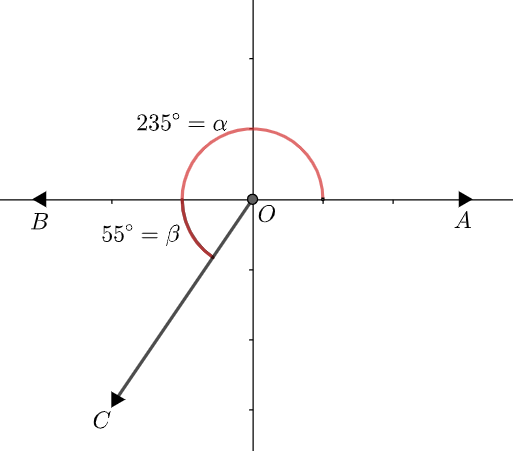
How do you sketch the angle 235 degrees and find its reference angle?
Answer
543.9k+ views
Hint: To draw the graph at first we need to know about the quadrants. Since each quadrant is measured as 90 degrees we can conclude that the angle 235 degrees falls in the ${{3}^{rd}}$ quadrant. Then starting from ${{1}^{st}}$ quadrant try to draw the angle by measuring 55 degrees in the ${{3}^{rd}}$ quadrant in an anticlockwise direction. For reference angle measure the closest distance (angle) from where the angle terminates to the ‘x’-axis.
Complete step by step answer:
As we know there are 4 quadrants and one complete rotation around the coordinate axes is 360 degrees, so each quadrant is of $360\div 4=90$ degrees.
Considering our angle ${{235}^{\circ }}=2\times {{90}^{\circ }}+{{55}^{\circ }}$
So, the angle should be in ${{3}^{rd}}$ quadrant as it exceeds two 90 degrees.
For drawing the angle we should start from the ${{1}^{st}}$ quadrant in anti-clockwise direction.
After passing ${{1}^{st}}$ and ${{2}^{nd}}$ quadrant i.e.$90+90=180$ degrees, draw measuring the rest 55 degrees in the ${{3}^{rd}}$ quadrant.

From the above graph we can conclude that the angle $\angle AOC={{235}^{\circ }}$ which is denoted as ‘$\alpha $’.
Reference angle: It is the angle that the given angle makes with the ‘x’- axis. It measures the closest distance from where the given angle terminates with the ‘x’- axis.
So, from the above graph the reference angle is $\angle BOC={{55}^{\circ }}$ which is denoted as ‘$\beta $’.
Note: The required angle should be measured from the ${{1}^{st}}$ quadrant in an anti-clockwise direction. The reference angle can also be defined as the acute angle from where the given angle terminates to the ‘x’- axis. Hence $\angle BOC={{55}^{\circ }}$ is the reference angle here.
Complete step by step answer:
As we know there are 4 quadrants and one complete rotation around the coordinate axes is 360 degrees, so each quadrant is of $360\div 4=90$ degrees.
Considering our angle ${{235}^{\circ }}=2\times {{90}^{\circ }}+{{55}^{\circ }}$
So, the angle should be in ${{3}^{rd}}$ quadrant as it exceeds two 90 degrees.
For drawing the angle we should start from the ${{1}^{st}}$ quadrant in anti-clockwise direction.
After passing ${{1}^{st}}$ and ${{2}^{nd}}$ quadrant i.e.$90+90=180$ degrees, draw measuring the rest 55 degrees in the ${{3}^{rd}}$ quadrant.

From the above graph we can conclude that the angle $\angle AOC={{235}^{\circ }}$ which is denoted as ‘$\alpha $’.
Reference angle: It is the angle that the given angle makes with the ‘x’- axis. It measures the closest distance from where the given angle terminates with the ‘x’- axis.
So, from the above graph the reference angle is $\angle BOC={{55}^{\circ }}$ which is denoted as ‘$\beta $’.
Note: The required angle should be measured from the ${{1}^{st}}$ quadrant in an anti-clockwise direction. The reference angle can also be defined as the acute angle from where the given angle terminates to the ‘x’- axis. Hence $\angle BOC={{55}^{\circ }}$ is the reference angle here.
Recently Updated Pages
Master Class 9 Social Science: Engaging Questions & Answers for Success

Master Class 9 Science: Engaging Questions & Answers for Success

Master Class 9 English: Engaging Questions & Answers for Success

Master Class 9 Maths: Engaging Questions & Answers for Success

Master Class 11 Economics: Engaging Questions & Answers for Success

Master Class 11 English: Engaging Questions & Answers for Success

Trending doubts
Which places in India experience sunrise first and class 9 social science CBSE

Fill the blanks with the suitable prepositions 1 The class 9 english CBSE

Write the 6 fundamental rights of India and explain in detail

Difference Between Plant Cell and Animal Cell

What is the Full Form of ISI and RAW

Golden Revolution is related to AFood production BOil class 9 social science CBSE




